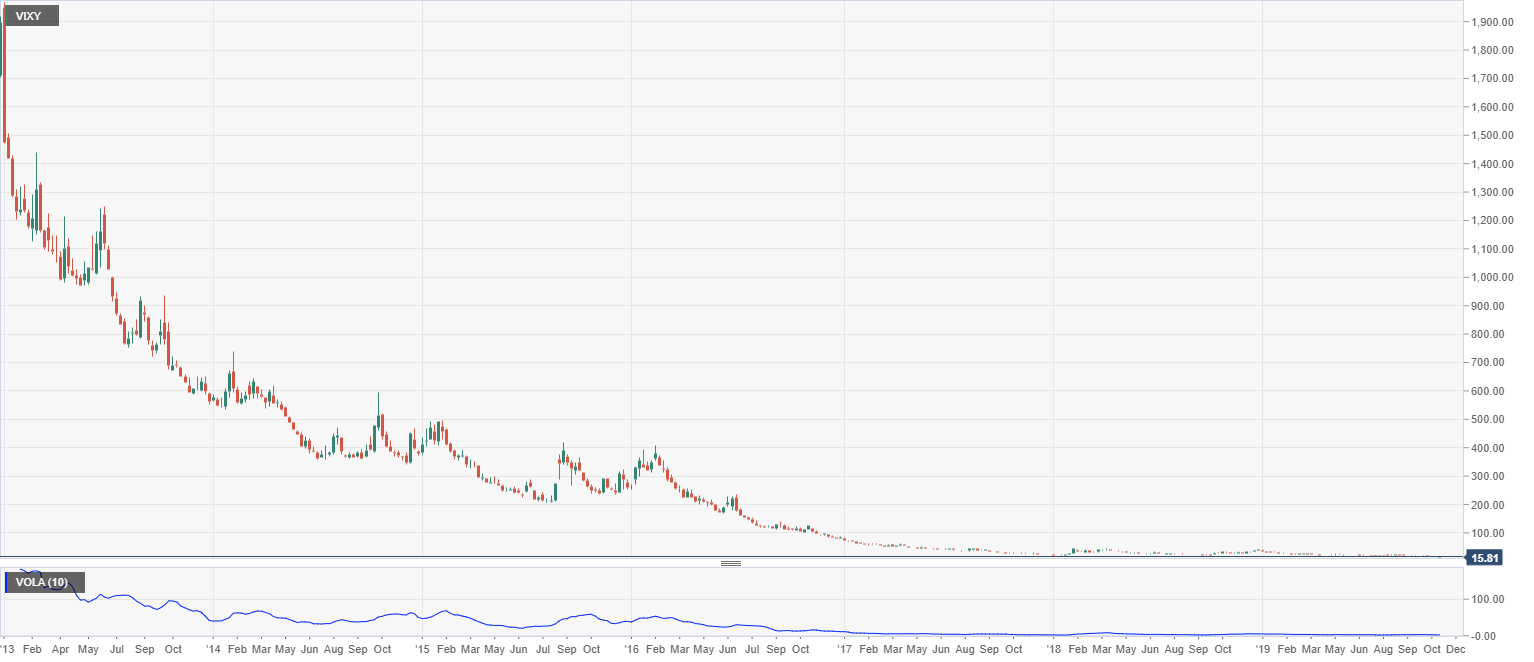- The VIXY ETF reaches lows never seen before.
- This instrument brings volatility trading closer to traders who don't want to leverage their bet.
- Stock markets are unprecedented extremes, in price, in volatility – and in complacency.
The leading American stock indices continue to beat records and shatter forecasts.
Many investors are trapped in bearish positions, wondering when a market that has been rising for more than ten years will turn and with clear signs of an economic slowdown.
For this analysis, the VIX (VIXY volatility ETF) chart comes handy. The VIXY Exchange Traded Fund (ETF) seeks to track the performance of the S&P 500 VIX Short-Term Futures Index.
This ETF quantifies the level of the implied volatility of the S&P500 index. In classical trading, the bearish phases of the market bring with them an increase in the levels of volatility, understood as a measurement of the prevailing fear in the trading pits.

Volatility clusters like duck flocks
Benoit Mandelbrot provides one of the most definite views of volatility in his book "The (mis) behaviour of markets: a fractal view of risk, ruin, and reward"-.
One of the book's most valuable concepts is that it talks about the tendency for volatility to be grouped into phases. Low volatility has been clustering for almost a decade until reaching lows never seen before.
According to Mandelbrot, when the market turns around, and volatility starts to increase, the scenario will be the opposite. Extremely high levels of volatility can be reached in the same way – hitting highs unseen in the past and enduring for a prolonged period.
The long-term graph dates back to the beginning of 2013. At that time, the value of a stake in this VIX ETF was approximately $1,900, while today it is less than $16.
The trough of the series was reached on Monday, November 4, with $15.26 per ETF share.
-637087356395572230.png)
The SMA200 is currently trading for $22.26, which represents a potential gain of 40.97% (+$6.46).
The SMA100 currently passes for $19.89, which represents a potential gain of +25.65% (+$4.06).
The EMA 50 currently passes for $18.46, which represents a potential gain of +17.04% (+$2.69).
The short term volatility indicator marked the low point of the series on October 29, with a level of 0.36, and since that day it has not stopped growing, even with lower prices.
Information on these pages contains forward-looking statements that involve risks and uncertainties. Markets and instruments profiled on this page are for informational purposes only and should not in any way come across as a recommendation to buy or sell in these assets. You should do your own thorough research before making any investment decisions. FXStreet does not in any way guarantee that this information is free from mistakes, errors, or material misstatements. It also does not guarantee that this information is of a timely nature. Investing in Open Markets involves a great deal of risk, including the loss of all or a portion of your investment, as well as emotional distress. All risks, losses and costs associated with investing, including total loss of principal, are your responsibility. The views and opinions expressed in this article are those of the authors and do not necessarily reflect the official policy or position of FXStreet nor its advertisers. The author will not be held responsible for information that is found at the end of links posted on this page.
If not otherwise explicitly mentioned in the body of the article, at the time of writing, the author has no position in any stock mentioned in this article and no business relationship with any company mentioned. The author has not received compensation for writing this article, other than from FXStreet.
FXStreet and the author do not provide personalized recommendations. The author makes no representations as to the accuracy, completeness, or suitability of this information. FXStreet and the author will not be liable for any errors, omissions or any losses, injuries or damages arising from this information and its display or use. Errors and omissions excepted.
The author and FXStreet are not registered investment advisors and nothing in this article is intended to be investment advice.
Recommended Content
Editors’ Picks
EUR/USD trades with negative bias, holds above 1.0700 as traders await US PCE Price Index

EUR/USD edges lower during the Asian session on Friday and moves away from a two-week high, around the 1.0740 area touched the previous day. Spot prices trade around the 1.0725-1.0720 region and remain at the mercy of the US Dollar price dynamics ahead of the crucial US data.
USD/JPY jumps above 156.00 on BoJ's steady policy

USD/JPY has come under intense buying pressure, surging past 156.00 after the Bank of Japan kept the key rate unchanged but tweaked its policy statement. The BoJ maintained its fiscal year 2024 and 2025 core inflation forecasts, disappointing the Japanese Yen buyers.
Gold price flatlines as traders look to US PCE Price Index for some meaningful impetus

Gold price lacks any firm intraday direction and is influenced by a combination of diverging forces. The weaker US GDP print and a rise in US inflation benefit the metal amid subdued USD demand. Hawkish Fed expectations cap the upside as traders await the release of the US PCE Price Index.
Sei Price Prediction: SEI is in the zone of interest after a 10% leap

Sei price has been in recovery mode for almost ten days now, following a fall of almost 65% beginning in mid-March. While the SEI bulls continue to show strength, the uptrend could prove premature as massive bearish sentiment hovers above the altcoin’s price.
US core PCE inflation set to signal firm price pressures as markets delay Federal Reserve rate cut bets

The core PCE Price Index, which excludes volatile food and energy prices, is seen as the more influential measure of inflation in terms of Fed positioning. The index is forecast to rise 0.3% on a monthly basis in March, matching February’s increase.